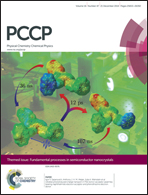Why do the [PhSiO1.5]8,10,12 cages self-brominate primarily in the ortho position? Modeling reveals a strong cage influence on the mechanism†
Abstract
(PhSiO1.5)8,10,12 cages are bulky, electron withdrawing like CF3; yet self-brominate (60 °C), favoring ortho substitution: PhT8 (≈85%), PhT10 (≈75%) and PhT12 (60%). First-principles calculations suggest bromination initiates when Br2 is “trapped” via H-bonding to ortho-H's, followed by polarization via strong interactions with cage faces, possibly cage LUMOs.
![Graphical abstract: Why do the [PhSiO1.5]8,10,12 cages self-brominate primarily in the ortho position? Modeling reveals a strong cage influence on the mechanism](/en/Image/Get?imageInfo.ImageType=GA&imageInfo.ImageIdentifier.ManuscriptID=C4CP03997A&imageInfo.ImageIdentifier.Year=2014)

 Please wait while we load your content...
Please wait while we load your content...